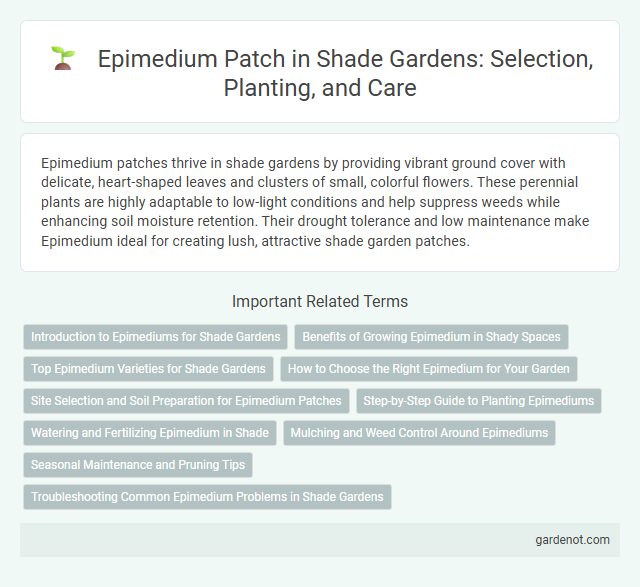Epimedium patches thrive in shade gardens by providing vibrant ground cover with delicate, heart-shaped leaves and clusters of small, colorful flowers. These perennial plants are highly adaptable to low-light conditions and help suppress weeds while enhancing soil moisture retention. Their drought tolerance and low maintenance make Epimedium ideal for creating lush, attractive shade garden patches.
Introduction to Epimediums for Shade Gardens
Epimediums, also known as barrenworts, are versatile perennial plants ideal for shade gardens due to their tolerance of low light and dry soil conditions. These hardy groundcovers feature delicate, heart-shaped leaves and produce charming, nodding flowers in spring, adding texture and color beneath trees or in woodland settings. Their resilience and low maintenance make Epimedium patches a popular choice for creating lush, evergreen understory in shaded garden areas.
Benefits of Growing Epimedium in Shady Spaces
Epimedium thrives in shaded garden areas, providing excellent ground cover that suppresses weeds and reduces soil erosion. Its drought-tolerant nature and resistance to deer make it a low-maintenance choice for enhancing soil health and adding vibrant, delicate blooms in low-light conditions. Growing Epimedium in shade gardens improves biodiversity by attracting pollinators such as bees and beneficial insects.
Top Epimedium Varieties for Shade Gardens
Epimedium varieties such as Epimedium x versicolor 'Sulphureum,' Epimedium grandiflorum, and Epimedium pinnatum 'Frohnleiten' are top choices for shade gardens due to their vibrant foliage and delicate spring blooms. These species thrive in dappled shade and well-drained soil, providing reliable ground cover that suppresses weeds and enhances garden texture. Their resilience to drought and deer makes Epimedium patches an ideal low-maintenance option for shaded garden areas.
How to Choose the Right Epimedium for Your Garden
Selecting the right Epimedium for your shade garden involves evaluating species based on leaf texture, flower color, and hardiness zones, typically USDA zones 5 to 9. Opt for varieties like Epimedium grandiflorum for vibrant blooms or Epimedium x rubrum for striking red foliage that enhances shaded areas. Consider soil type and moisture preferences, ensuring well-drained, humus-rich soil to promote healthy growth and long-lasting garden appeal.
Site Selection and Soil Preparation for Epimedium Patches
Epimedium patches thrive in well-drained, humus-rich soils with consistent moisture and partial to full shade environments, making them ideal for woodland or shaded garden areas. Selecting a site with protection from harsh afternoon sun and strong winds encourages healthy growth and vibrant foliage. Prior to planting, incorporating organic matter such as compost or leaf mold improves soil structure and nutrient content, enhancing root establishment and long-term vitality of Epimedium patches.
Step-by-Step Guide to Planting Epimediums
Prepare well-drained, humus-rich soil in a shaded area with dappled sunlight for optimal Epimedium growth. Plant rhizomes 12 to 18 inches apart at a depth of 2 inches, covering roots lightly with soil and watering thoroughly after planting. Mulch the area to retain moisture and suppress weeds, maintaining consistent moisture during the first growing season to establish a healthy Epimedium patch.
Watering and Fertilizing Epimedium in Shade
Epimedium thrives in shaded garden areas with consistently moist, well-drained soil, requiring regular watering to maintain optimal hydration without waterlogging. Applying a balanced, slow-release fertilizer in early spring encourages vigorous growth and vibrant foliage while avoiding excessive nitrogen that can reduce flowering. Mulching around the base helps retain soil moisture and regulate temperature, supporting healthy development throughout the growing season.
Mulching and Weed Control Around Epimediums
Mulching around Epimedium patches conserves soil moisture, regulates temperature, and suppresses weed growth effectively. Organic mulches such as shredded leaves or bark enrich the soil as they decompose, enhancing nutrient availability for Epimediums. Consistent mulching combined with manual weed removal ensures optimal growth and prevents competition for resources in shaded garden areas.
Seasonal Maintenance and Pruning Tips
Epimedium patches thrive with seasonal maintenance that includes clearing dead leaves in early spring to promote fresh growth and improve air circulation. Pruning involves cutting back old, damaged foliage before new leaves emerge to maintain plant health and enhance flowering. Regular removal of spent flowers and thinning dense patches encourages more vibrant blooms and prevents overcrowding in shaded garden areas.
Troubleshooting Common Epimedium Problems in Shade Gardens
Epimedium patches in shade gardens often face issues such as leaf scorch, caused by excessive sun exposure or drought stress, and fungal diseases like leaf spot and powdery mildew due to poor air circulation and high humidity. To troubleshoot these problems, ensure proper watering, provide adequate mulch to retain moisture, and improve airflow by thinning surrounding plants. Regular removal of affected leaves and applying fungicides can effectively control fungal infections and promote healthy growth in Epimedium patches.
Epimedium patch Infographic

 gardenot.com
gardenot.com